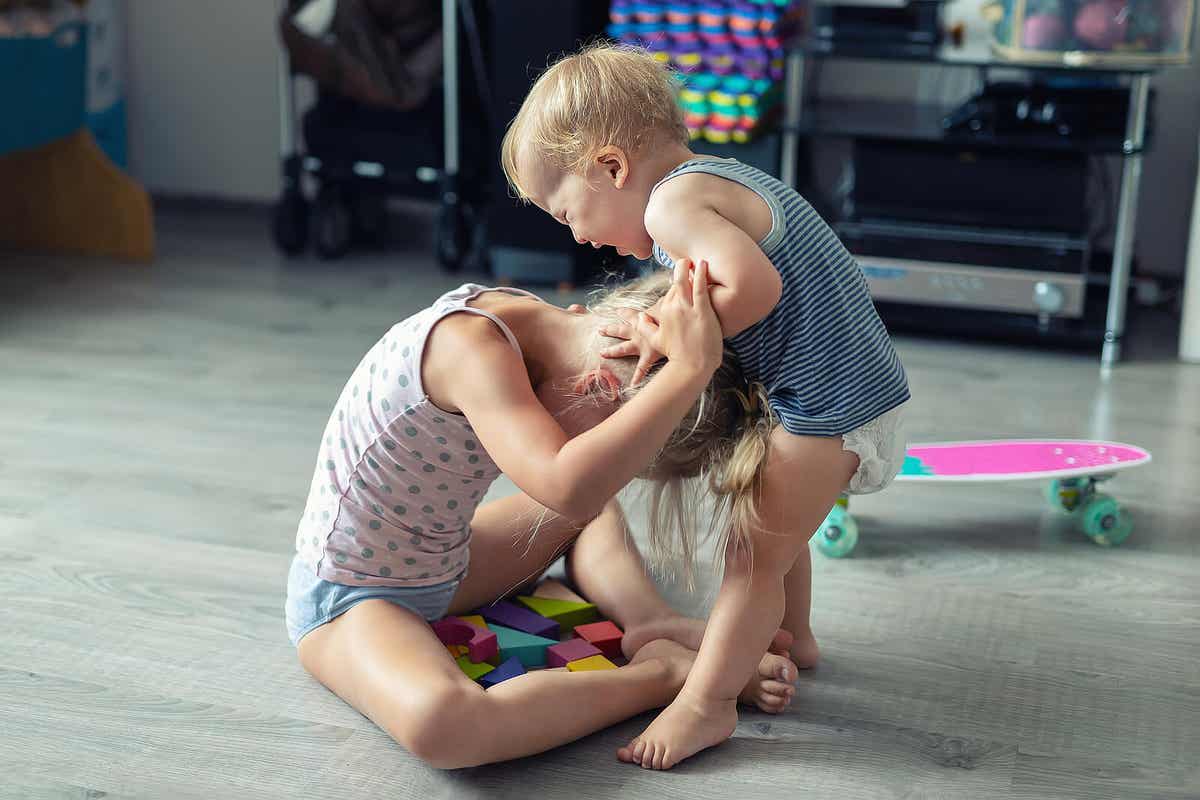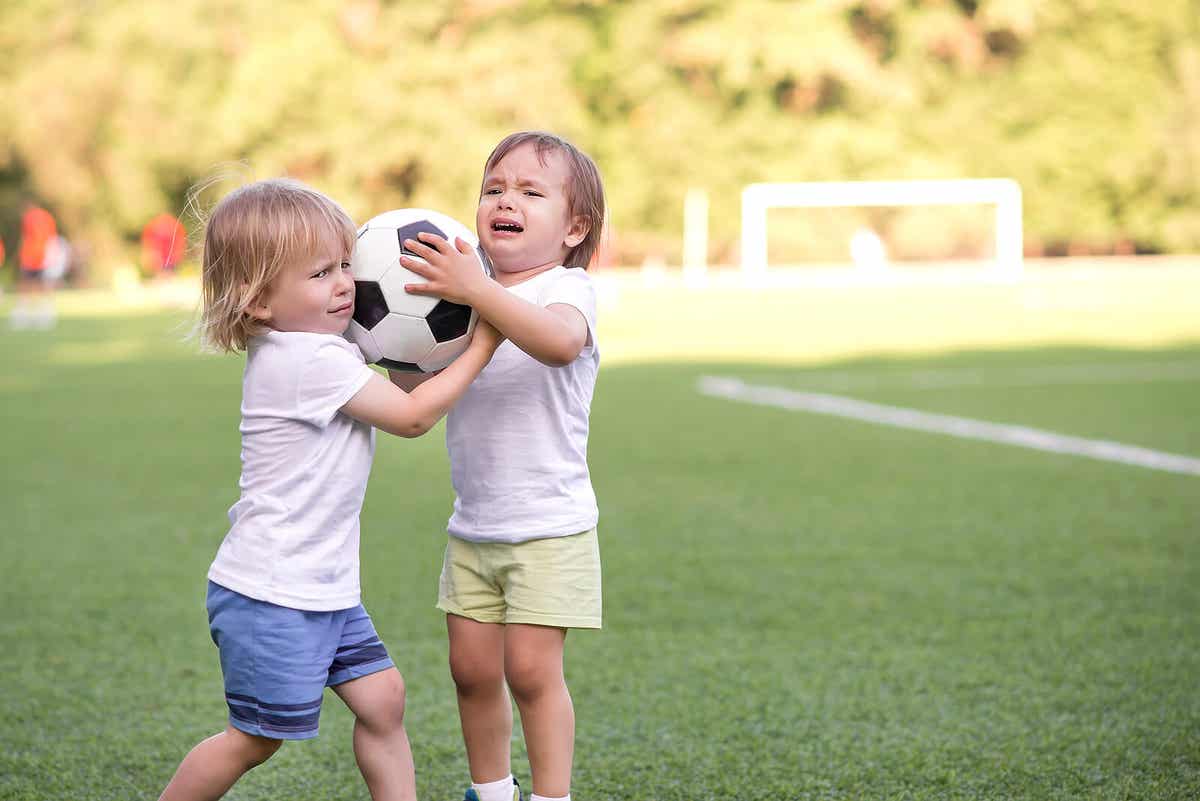9 Steps for Kids to Resolve Conflicts

During childhood, it’s normal for kids to disagree, whether they’re friends, classmates, cousins, siblings, etc. Disagreements can happen for different reasons and need a solution. Faced with these situations, fathers, mothers, and teachers often feel lost and don’t know how to manage these complicated moments. Fortunately, we can help them solve these issues and learn from them. Next, we’re going to see what steps to take to help kids to resolve conflicts.
Conflicts between children
Arguments or conflicts between kids appear often and are normal during childhood. In addition, the disagreements that kids have are necessary in order to gradually shape their personalities.

Everyone has desires, opinions, tastes, ideas, or needs that make these issues appear. Ideally, with the help of adults, children learn to tolerate, face, and manage possible solutions to these conflicts.
Children have to learn, with our help, that there are lots of opinions and desires, as many as there are people in the world. Often, we don’t think or want the same thing as others. The important thing is that they learn to empathize and listen to better understand the other person. And that’s the best way for kids to resolve conflicts.
Great lessons can also come from conflicts that help us grow and evolve as people. So, solving conflicts will help them learn more about other people, and also about themselves. We need to take advantage of these moments to work on different values, like education, understanding, empathy, socialization, assertiveness, etc.
Before this, we have to know how we can help kids resolve conflicts step by step.
Steps for helping kids to resolve conflicts
How can we resolve conflicts between children? We’re going to see how to do it. These are strategies that, once children have learned them, they can incorporate into their behavior and use them on their own in their daily lives.
The adult’s mission here is to guide and accompany the kids, but the kids will have to work to achieve it. Obviously, it will also depend on the kids’ age. Adults will be more or less relevant, and age may determine the tips you choose to apply.
Identify the problem
The first thing you have to do when a conflict arises between kids is to find out what has happened. To do this, you need to ask them directly what happened and allow the kids to give your their version of the events.
Each one will give their side. The kids may or may not agree, but at least they’ll tell you what they think happened and how they feel. The basis for resolving conflicts is identifying the underlying problem.
Offer a space for them to express themselves
Continuing with the previous step, now you need to give them a space to express themselves and tell you how they felt during the conflict and how they feel now. Some questions you can ask them are:
- How has this problem with … made you feel?
- Do you think you handled it well?
- Do you think … handled it well?
Ask both kids these questions. That way, they listen when the other child responds, without interrupting.
Encourage mutual understanding
Now, in addition to listening to each other, you need to try to get them to put themselves in one another’s shoes and understand one another. Even if they don’t understand at first, they have to try.
Here, the adult needs to intervene to explain why each one acted the way they did. If they don’t fully understand each other, at least they have come to respect each other.
Find solutions together
This step is also key because you’ll help them find solutions to the conflict they just had. Each child can contribute different ideas on how to solve the problem and reach a solution.
Here, we adults can help them out. You can try and help smooth it over and try to bring them closer together.
Teach them to manage their emotions
We all know the importance of emotional education in helping children manage their emotions. Emotions sometimes lead us to carry out actions that aren’t appropriate and we can end up hurting others. Therefore, we need to know how to control them.
Adults must set an example and teach them different ways to act, avoiding yelling, hitting, or hurting one another. You can use alternative behaviors like speaking calmly, breathing and counting to 10, thinking before speaking, not hitting or shouting, putting yourself in the other person’s shoes, etc.
More steps to resolve conflicts between kids

Promote negotiation
This step attempts to make a kind of “pact” to understand what happened and follow a pattern to move on. For example, don’t interrupt the other person when they’re concentrating on something, listen before speaking, take turns watching TV and playing with toys, etc.
You have to teach them the importance of being flexible and open with each other. In addition, they’ll feel much better agreeing on something they both like.
Apologize if necessary
Sometimes, conflict means that both or one of them has acted poorly, and it’s important to be aware of their behavior and apologize. Children need to learn the value of forgiveness and repentance. Saying it out loud makes us brave because we recognize that we’ve done something wrong.
Track conflicts between children
Most of the time, conflicts happen every once in a while. However, if they happen often between the same kids, like at school, it’s important to follow up to be able to solve this problem and act accordingly.
If it’s between siblings, parents should see if they’re frequent. Then, assess the situation to find the best solution.
In short, these steps resolve conflicts between children and can be very helpful when they fight. Sometimes we don’t know how to intervene, we lose our cool, and we might even end up yelling. However, this is something we should try to avoid at all costs.
If you follow these steps, with practice, your kids will learn them. Over time, they’ll be able to solve their own problems without needing adults to intervene.
During childhood, it’s normal for kids to disagree, whether they’re friends, classmates, cousins, siblings, etc. Disagreements can happen for different reasons and need a solution. Faced with these situations, fathers, mothers, and teachers often feel lost and don’t know how to manage these complicated moments. Fortunately, we can help them solve these issues and learn from them. Next, we’re going to see what steps to take to help kids to resolve conflicts.
Conflicts between children
Arguments or conflicts between kids appear often and are normal during childhood. In addition, the disagreements that kids have are necessary in order to gradually shape their personalities.

Everyone has desires, opinions, tastes, ideas, or needs that make these issues appear. Ideally, with the help of adults, children learn to tolerate, face, and manage possible solutions to these conflicts.
Children have to learn, with our help, that there are lots of opinions and desires, as many as there are people in the world. Often, we don’t think or want the same thing as others. The important thing is that they learn to empathize and listen to better understand the other person. And that’s the best way for kids to resolve conflicts.
Great lessons can also come from conflicts that help us grow and evolve as people. So, solving conflicts will help them learn more about other people, and also about themselves. We need to take advantage of these moments to work on different values, like education, understanding, empathy, socialization, assertiveness, etc.
Before this, we have to know how we can help kids resolve conflicts step by step.
Steps for helping kids to resolve conflicts
How can we resolve conflicts between children? We’re going to see how to do it. These are strategies that, once children have learned them, they can incorporate into their behavior and use them on their own in their daily lives.
The adult’s mission here is to guide and accompany the kids, but the kids will have to work to achieve it. Obviously, it will also depend on the kids’ age. Adults will be more or less relevant, and age may determine the tips you choose to apply.
Identify the problem
The first thing you have to do when a conflict arises between kids is to find out what has happened. To do this, you need to ask them directly what happened and allow the kids to give your their version of the events.
Each one will give their side. The kids may or may not agree, but at least they’ll tell you what they think happened and how they feel. The basis for resolving conflicts is identifying the underlying problem.
Offer a space for them to express themselves
Continuing with the previous step, now you need to give them a space to express themselves and tell you how they felt during the conflict and how they feel now. Some questions you can ask them are:
- How has this problem with … made you feel?
- Do you think you handled it well?
- Do you think … handled it well?
Ask both kids these questions. That way, they listen when the other child responds, without interrupting.
Encourage mutual understanding
Now, in addition to listening to each other, you need to try to get them to put themselves in one another’s shoes and understand one another. Even if they don’t understand at first, they have to try.
Here, the adult needs to intervene to explain why each one acted the way they did. If they don’t fully understand each other, at least they have come to respect each other.
Find solutions together
This step is also key because you’ll help them find solutions to the conflict they just had. Each child can contribute different ideas on how to solve the problem and reach a solution.
Here, we adults can help them out. You can try and help smooth it over and try to bring them closer together.
Teach them to manage their emotions
We all know the importance of emotional education in helping children manage their emotions. Emotions sometimes lead us to carry out actions that aren’t appropriate and we can end up hurting others. Therefore, we need to know how to control them.
Adults must set an example and teach them different ways to act, avoiding yelling, hitting, or hurting one another. You can use alternative behaviors like speaking calmly, breathing and counting to 10, thinking before speaking, not hitting or shouting, putting yourself in the other person’s shoes, etc.
More steps to resolve conflicts between kids

Promote negotiation
This step attempts to make a kind of “pact” to understand what happened and follow a pattern to move on. For example, don’t interrupt the other person when they’re concentrating on something, listen before speaking, take turns watching TV and playing with toys, etc.
You have to teach them the importance of being flexible and open with each other. In addition, they’ll feel much better agreeing on something they both like.
Apologize if necessary
Sometimes, conflict means that both or one of them has acted poorly, and it’s important to be aware of their behavior and apologize. Children need to learn the value of forgiveness and repentance. Saying it out loud makes us brave because we recognize that we’ve done something wrong.
Track conflicts between children
Most of the time, conflicts happen every once in a while. However, if they happen often between the same kids, like at school, it’s important to follow up to be able to solve this problem and act accordingly.
If it’s between siblings, parents should see if they’re frequent. Then, assess the situation to find the best solution.
In short, these steps resolve conflicts between children and can be very helpful when they fight. Sometimes we don’t know how to intervene, we lose our cool, and we might even end up yelling. However, this is something we should try to avoid at all costs.
If you follow these steps, with practice, your kids will learn them. Over time, they’ll be able to solve their own problems without needing adults to intervene.
All cited sources were thoroughly reviewed by our team to ensure their quality, reliability, currency, and validity. The bibliography of this article was considered reliable and of academic or scientific accuracy.
- Alzate, R. (2005). Programas de convivencia en el ámbito educativo: Enfoque global de transformación de conflictos y mediación escolar. La mediación, una visión plural: 1-18.
- Guerrero Ortiz, L. (1994). Aprendiendo a convivir. Estrategias para resolver conflictos con los niños en la escuela y en la familia. Infancia y Sociedad. 2.
- Carrasco, A., & Schade, N. (2013). Estrategias que utilizan las educadoras de párvulos en el aula inicial para abordar los conflictos entre niños y niñas de 4 a 6 años de edad. Psicoperspectivas, 12(2), 104-116.
This text is provided for informational purposes only and does not replace consultation with a professional. If in doubt, consult your specialist.








